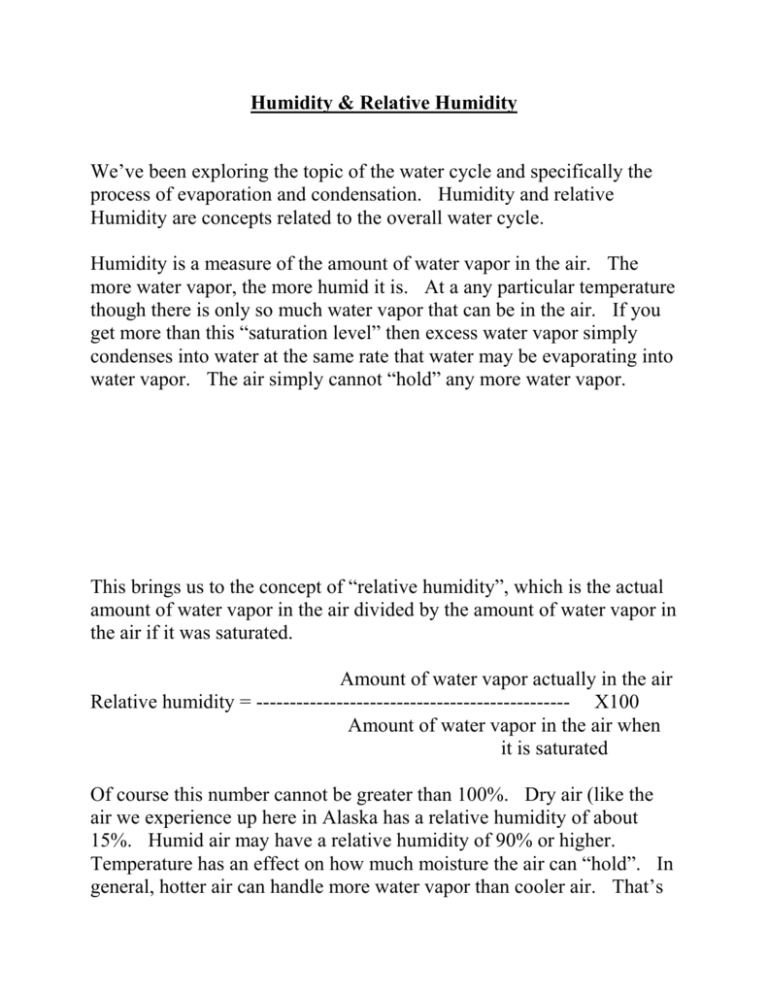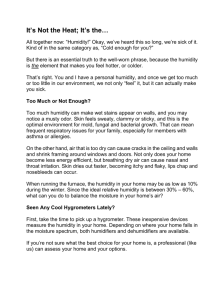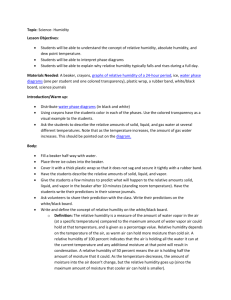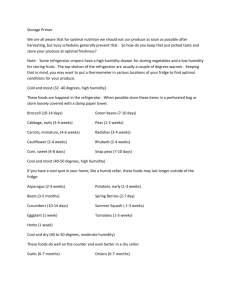Humidity & Relative Humidity
advertisement

Humidity & Relative Humidity We’ve been exploring the topic of the water cycle and specifically the process of evaporation and condensation. Humidity and relative Humidity are concepts related to the overall water cycle. Humidity is a measure of the amount of water vapor in the air. The more water vapor, the more humid it is. At a any particular temperature though there is only so much water vapor that can be in the air. If you get more than this “saturation level” then excess water vapor simply condenses into water at the same rate that water may be evaporating into water vapor. The air simply cannot “hold” any more water vapor. This brings us to the concept of “relative humidity”, which is the actual amount of water vapor in the air divided by the amount of water vapor in the air if it was saturated. Amount of water vapor actually in the air Relative humidity = ----------------------------------------------- X100 Amount of water vapor in the air when it is saturated Of course this number cannot be greater than 100%. Dry air (like the air we experience up here in Alaska has a relative humidity of about 15%. Humid air may have a relative humidity of 90% or higher. Temperature has an effect on how much moisture the air can “hold”. In general, hotter air can handle more water vapor than cooler air. That’s why a relative humidity of 80% is a whole lot more uncomfortable in the summer than the winter. Experiment: You are going to demonstrate the concepts of relative humidity to ensure that you fully understand it. Materials: 5 beakers of different sizes, 100mL, 250mL, 400mL, 600mL & 1000mL Labels: 40 degrees F, 50 degrees F, 60 degrees F, 70 degrees F, 80 degrees F Explanation: Each beaker represents the maximum volume of water a unit volume of air can hold at each specific temperature it is labeled. You should place the 80F label on the largest beaker, the 70F label on the next largest, and so on until all the beakers are labeled. Procedure and questions: Pour 50mL of water into the 100mL beaker (the one representing the amount of moisture the unit volume of air can hold at 40 degrees F). How full is the beaker? Therefore the relative humidity of the air at that temperature is __________? Now, pour the 50mL of water from the 100mL beaker into the 250mL beaker (air at 50 degrees F) What is the relative humidity of the air at 50 degrees F? In addition to the change in temperature, relative humidity is also affected by changes in the amount of water vapor added to a volume or unit of air due to evaporation. The evaporation of water from oceans, lakes, plants, animals and the ground due to higher temperatures can cause a significant increase in the amount of moisture in the air. Continuing with your 250mL beaker of air at 50 degrees F, if evaporation causes an additional 100mL of water to be added to the 50 degree F air how much is the relative humidity now? (Add 100mL of water to your 250mL beaker) Finally – we are going to model a humid day during the summer as if we experienced it. 7am: The temperature is 50 degrees F, and the relative humidity is 100% (your 250mL beaker should be completely full) 10am: The temperature is now 60 degrees F (Use your 400mL beaker to represent this). If no evaporation has occurred the 400mL beaker will only have the original 250mL water in it. The air’s relative humidity would therefore be 63% at 60 degrees F. However, evaporation has been occurring, so you must add another 70mL of water to the 250mL of water already contained in your 400mL beaker. How much water do you have in the unit of air now? _________ What is your relative humidity now?_________________ Later in the day it continues to get hotter until we reach 3pm. 3pm: It is the heat of the day, the temperature is now 80 degrees F (use your 1000mL beaker to represent this), and the air is at 60% relative humidity. How much water should you place in your 1000mL beaker to represent a relative humidity of 60%? Now the air is beginning to cool – how might this affect the relative humidity? Suppose the air cools to 70 degrees F (which you will represent with your 600mL beaker), and the air is at 60% relative humidity (600mL of water in your 1000mL beaker). Observe as you pour the water from the 1000mL beaker into the 600mL beaker how full it becomes. What is the relative humidity now at 70 degrees F? Continue to pour your water into each beaker of decreasing temperature, observe the water overflowing from each smaller beaker. What does the overflowing water represent? Questions: What is the difference between absolute humidity and relative humidity? What is the relative humidity of a 500mL beaker with 250mL water in it? How much water would the 500mL beaker require to represent 90% relative humidity? Describe how this experiment illustrates the correlation between air temperature and relative humidity. What happens to the percentage of relative humidity as the temperature increases? What happens to the percentage of relative humidity as the temperature decreases? Why does evaporation increase the relative humidity if the temperature remains constant? Explain why the overflow of water from the beakers represents precipitation.






